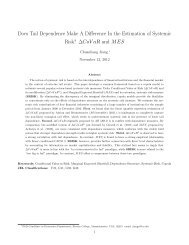Chapter 18. Introduction to Four Dimensions Linear algebra in four ...
Chapter 18. Introduction to Four Dimensions Linear algebra in four ...
Chapter 18. Introduction to Four Dimensions Linear algebra in four ...
Create successful ePaper yourself
Turn your PDF publications into a flip-book with our unique Google optimized e-Paper software.
where θ is the angle between v and v ′ , measured <strong>in</strong> any plane conta<strong>in</strong><strong>in</strong>g them.<br />
The cross-product generalizes, but <strong>in</strong> a less-obvious way; we’ll get <strong>to</strong> that <strong>in</strong> the<br />
next section.<br />
We now describe some objects which are new <strong>in</strong> <strong>four</strong> dimensions. A hyperplane<br />
<strong>in</strong> R 4 is the set of vec<strong>to</strong>rs u = (x, y, z, w) satisfy<strong>in</strong>g an equation of the<br />
form<br />
ax + by + cz + dw = 0,<br />
where a, b, c, d are fixed real numbers, not all zero. Alternatively, a hyperplane is<br />
a set of all l<strong>in</strong>ear comb<strong>in</strong>ations<br />
H = {xv1 + yv2 + zv3 : x, y, z <strong>in</strong> R},<br />
where v1, v2, v3 are some vec<strong>to</strong>rs not ly<strong>in</strong>g <strong>in</strong> a common plane. S<strong>in</strong>ce it takes<br />
three numbers (x, y, z) <strong>to</strong> specify a po<strong>in</strong>t, a hyperplane looks like R 3 and we call<br />
it three dimensional. Among the <strong>in</strong>f<strong>in</strong>itely many hyperplanes, there are <strong>four</strong><br />
coord<strong>in</strong>ate hyperplanes:<br />
(x = 0) is the hyperplane {(0, y, z, w) : y, z, w ∈ R}<br />
(y = 0) is the hyperplane {(x, 0, z, w) : x, z, w ∈ R}<br />
(z = 0) is the hyperplane {(x, y, 0, w) : x, y, w ∈ R}<br />
(w = 0) is the hyperplane {(x, y, z, 0) : x, y, z ∈ R}.<br />
Note that the (general) hyperplane<br />
ax + by + cz + dw = 0<br />
consists of the vec<strong>to</strong>rs orthogonal <strong>to</strong> the normal vec<strong>to</strong>r n = (a, b, c, d), which<br />
must be nonzero. The <strong>in</strong>tersection of two hyperplanes<br />
ax + by + cz + dw = 0<br />
a ′ x + b ′ y + c ′ z + d ′ w = 0<br />
with non-proportional normal vec<strong>to</strong>rs n = (a, b, c, d) and n ′ = (a ′ , b ′ , c ′ , d ′ ) is a<br />
plane. For example,<br />
(x = 0) ∩ (w = 0) = {(0, y, z, 0) : y, z ∈ R}<br />
is the yz-plane, spanned by e2 and e3.<br />
2

















